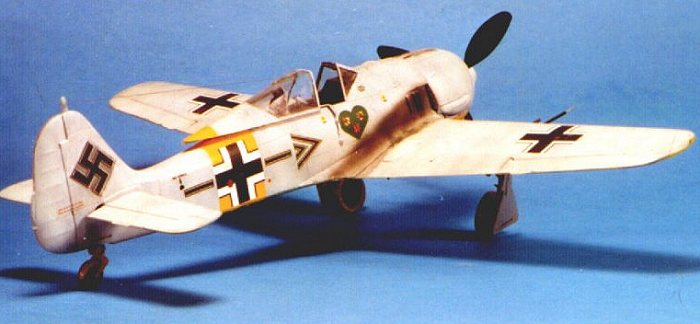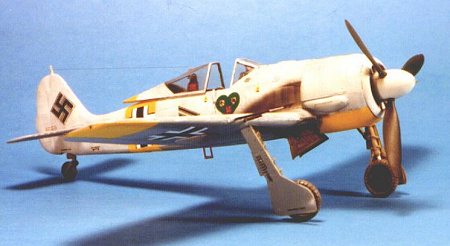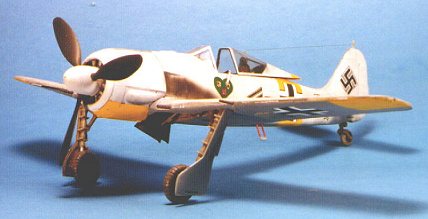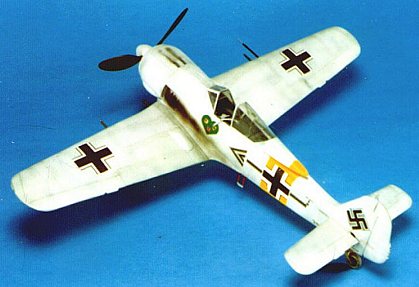
| Luftwaffe Winter Camouflage Schemes: Part 1 |
| Northern Front Jagdflieger |
| Hannes Trautloft's Fw-190A-4 |
| Lenningrad Front; Winter 1942/43 |
| Tom Cleaver |

Winter comes early in Russia and stays late. That was particularly true on the Northern Front outside Leningrad, where JG54 Grunherz was responsible for maintaining air superiority. The unit was re-equipped with Fw-109A-3 and A-4 aircraft from the Fall of 1942, replacing the Bf-109F-4 and G-2 fighters they had flown before. The Butcher Bird had an immediate impact on aerial fighting on the Eastern Front, demonstrating even greater superiority over its Soviet opponents than it had over RAF Spitfires when introduced the year before on the Channel Front.
 The Luftwaffe believed in the effectiveness of camouflage, and on the Eastern
Front it was felt the aircraft were most vulnerable when they were on the
ground. Accordingly, an all-over scheme of white was applied in early October,
using water-based paints applied over the standard camouflage scheme. Over the
course of the winter, this paint would scuff and peel from use, to be scrubbed
off the following Spring. At the outset, however, it was a very attractive
scheme, with the ground crew taking the time to carefully paint around national
insignia, and unit and personal markings.
The Luftwaffe believed in the effectiveness of camouflage, and on the Eastern
Front it was felt the aircraft were most vulnerable when they were on the
ground. Accordingly, an all-over scheme of white was applied in early October,
using water-based paints applied over the standard camouflage scheme. Over the
course of the winter, this paint would scuff and peel from use, to be scrubbed
off the following Spring. At the outset, however, it was a very attractive
scheme, with the ground crew taking the time to carefully paint around national
insignia, and unit and personal markings.
As a scheme for a modeler to apply, this is not as easy as it looks. If a modeler applies the white directly to the model, even with the panel lines "pre-shaded," it will be a very dead white, and because it is airbrushed it will look too smooth to be real.
Here's what I did:
First off, I painted the model - a Hasegawa/DML Fw-190A-4, in the standard factory scheme of RLM74/75/76, using Gunze-Sanyo paints. I use Gunze-Sanyo H-419 RLM76 "Hell Grau"; Gunze-Sanyo H-53 "Neutral Grey" for RLM75 "Grauviolett", due to its distinct purplish tint, which is not in the color Gunze created earlier as RLM75; and I make RLM74 "Graugrun" by mixing Gunze H-74 "IJN Green" 50-50 with Gunze H-335, "Blueish-Grey."
 Before shooting the camouflage, I painted the RLM04 "Gelb" theater
markings on the rar fuselage and the underside of the cowl, and masked those
off. I then "pre-shadowed" the airplane with flat black airbrushed
along the panel lines. I then proceeded with the camouflage, starting with the
lightest first - RLM76, then the RLM75 and ending with RLM74. I did only a light
mottling on the side of the fuselage and rudder, this being the standard 1942
factoy scheme. I shot a coat of Future over the model when this was all dry.
Before shooting the camouflage, I painted the RLM04 "Gelb" theater
markings on the rar fuselage and the underside of the cowl, and masked those
off. I then "pre-shadowed" the airplane with flat black airbrushed
along the panel lines. I then proceeded with the camouflage, starting with the
lightest first - RLM76, then the RLM75 and ending with RLM74. I did only a light
mottling on the side of the fuselage and rudder, this being the standard 1942
factoy scheme. I shot a coat of Future over the model when this was all dry.
I then masked off the area where the swastika would be on the rudder, and prepared to do the winter camouflage.
I used Tamiya XF-1 "Flat White," mixed 40-60 with rubbing alcohol, for this. I sprayed the paint lightly, making it thicker in some areas and lighter in others, so that the underlying pattern could be seen through the paint. Once finished, and before the paint had dried, I then took a 1/4" flat paint brush, dipped it in rubbing alcohol, and "painted" over the white paint. This left "brush marks" in the paint to give it that "brushed-on" look, though the coat of paint was still acceptably thin since it had been airbrushed. When this was dry, I shot another coat of Future over the paint to protect it for the application of decals.
 This particular kit came with the decals for Geschwader Kommodore
Hannes Trautloft's airplane, and I used those. The decals snugged down perfectly
with a brushful of Micro-Sol on each.
This particular kit came with the decals for Geschwader Kommodore
Hannes Trautloft's airplane, and I used those. The decals snugged down perfectly
with a brushful of Micro-Sol on each.
When the decals were dry, I shot the model with Future. When that was dry, I shot three coats of "Flat Future" - Future mixed 50-50 with Tamiya Flat Base - to get the flat finish I wanted. I then airbrushed exhaust and gunpowder stains where appropriate. I "muddied" the wheels with Tamiya Light Brown, and then dry-brushed "mud-splatter" on the lower wing and rudder behind the landing gear.
There you have the early war Eastern Front winter camouflage. This system can be used for any airplane that was painted this way. You can "age" the winter scheme by leaving "gaps" in it where the paint has worn away under the shoes of ground crew working on the airplane, and thinning the white coat with a bit more alcohol in the brush when you "brush it on."